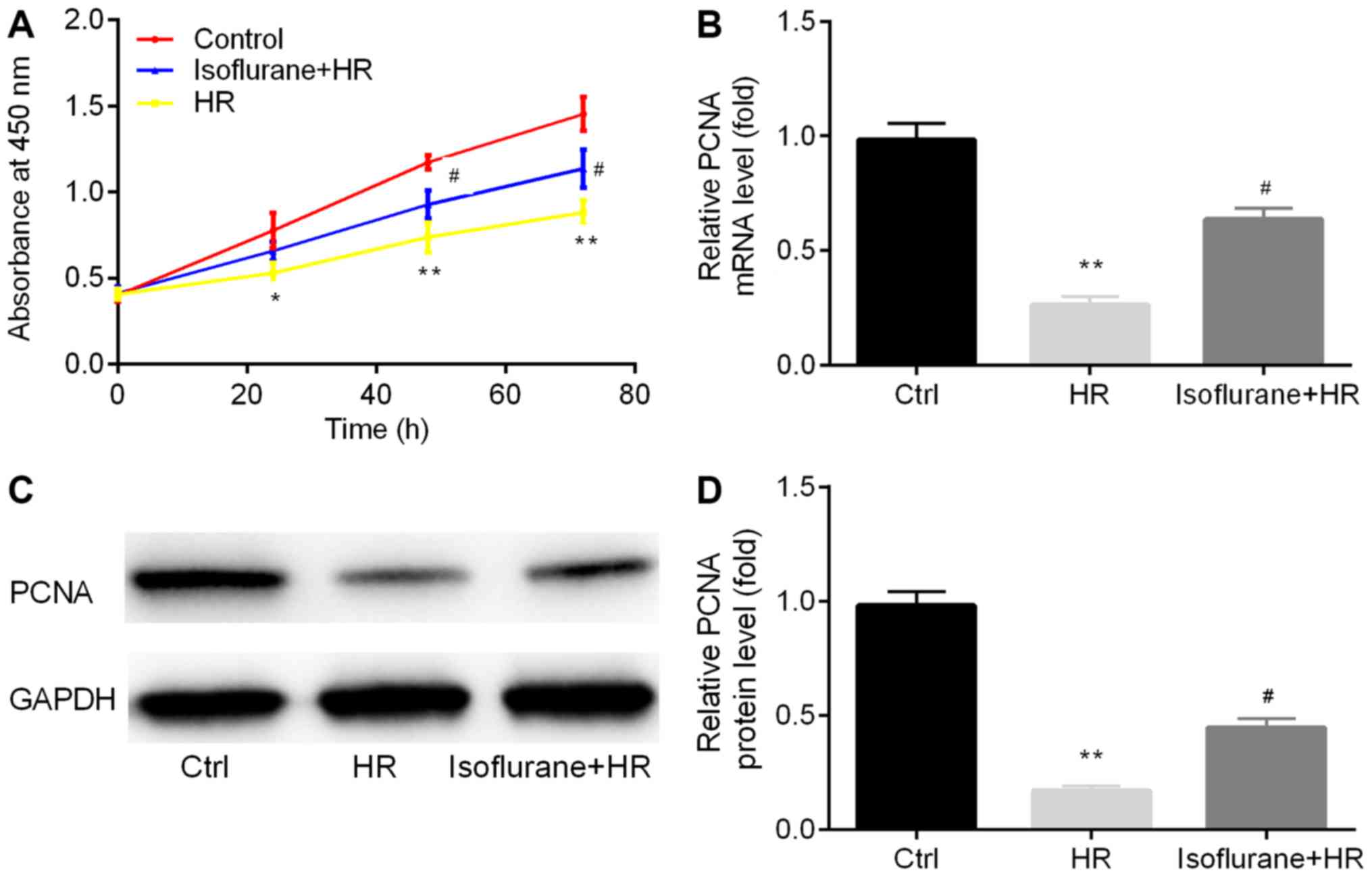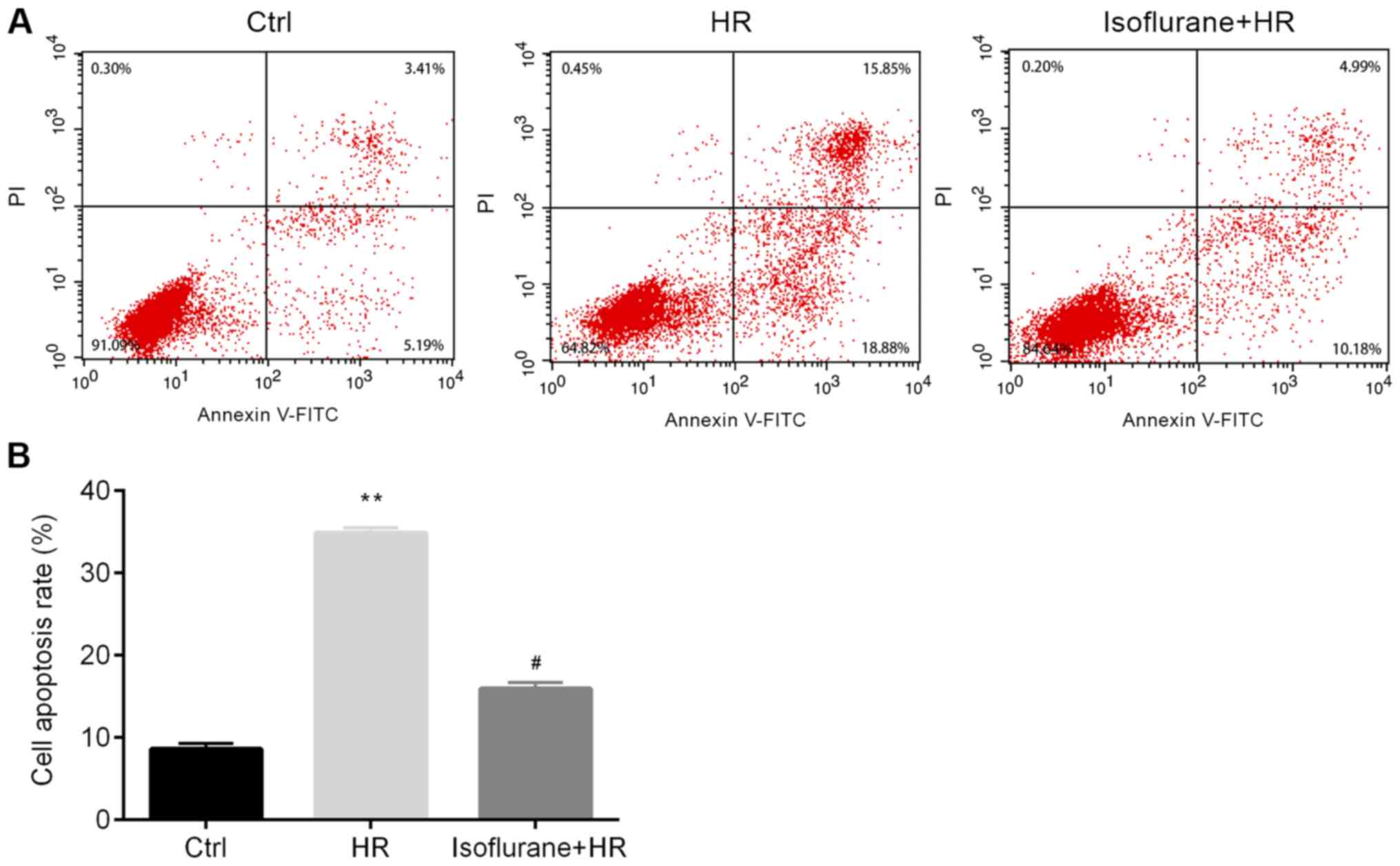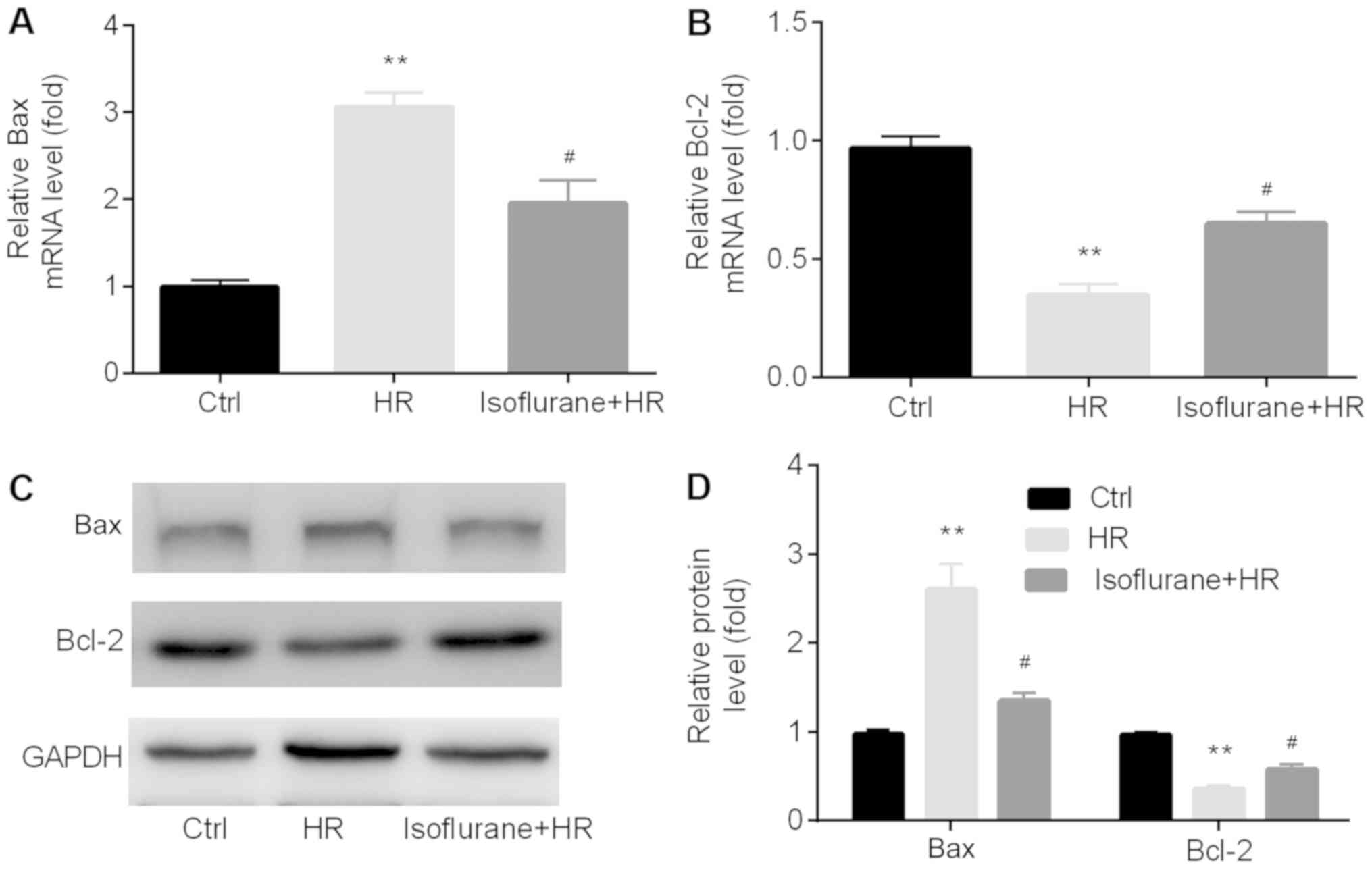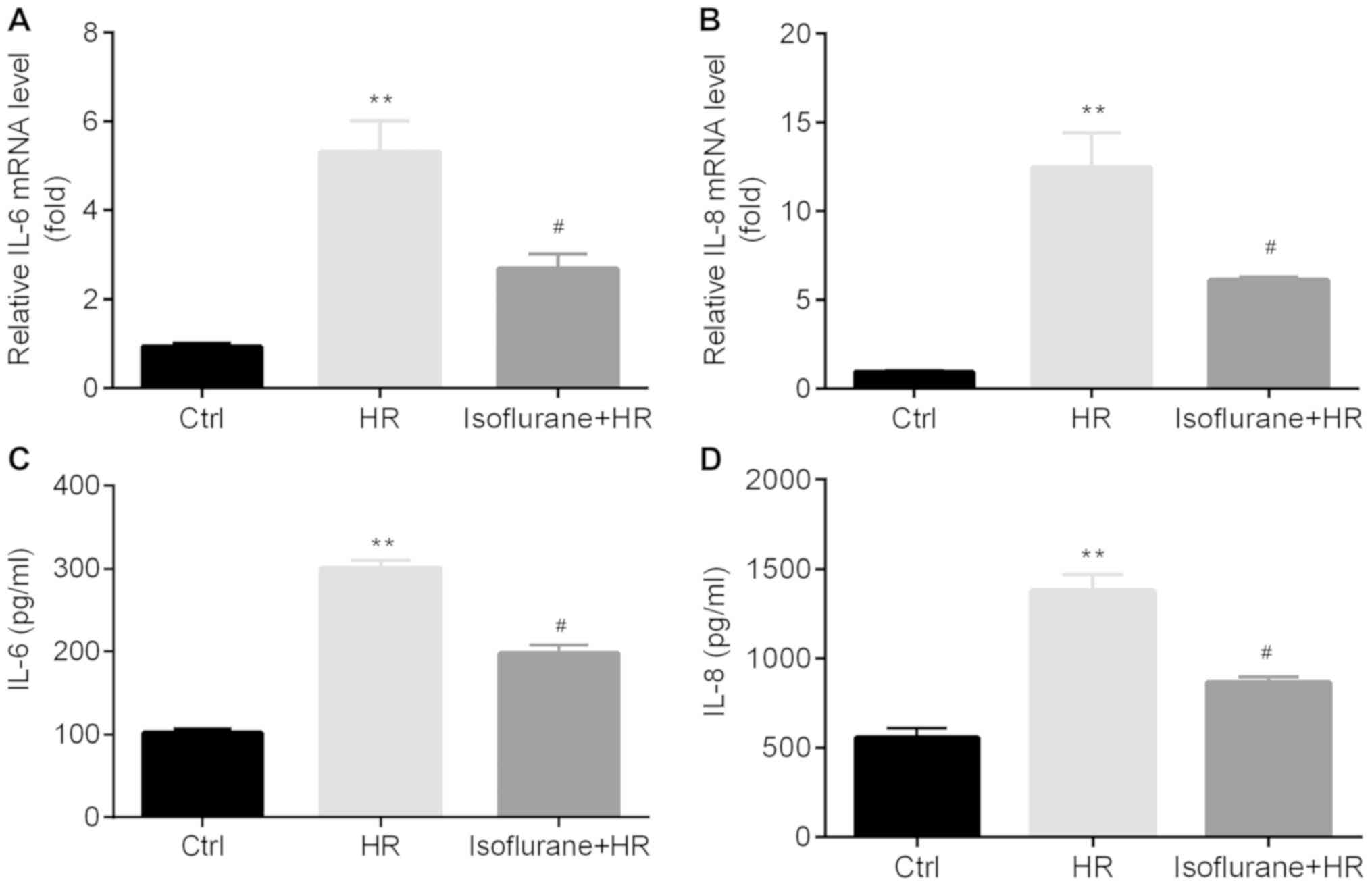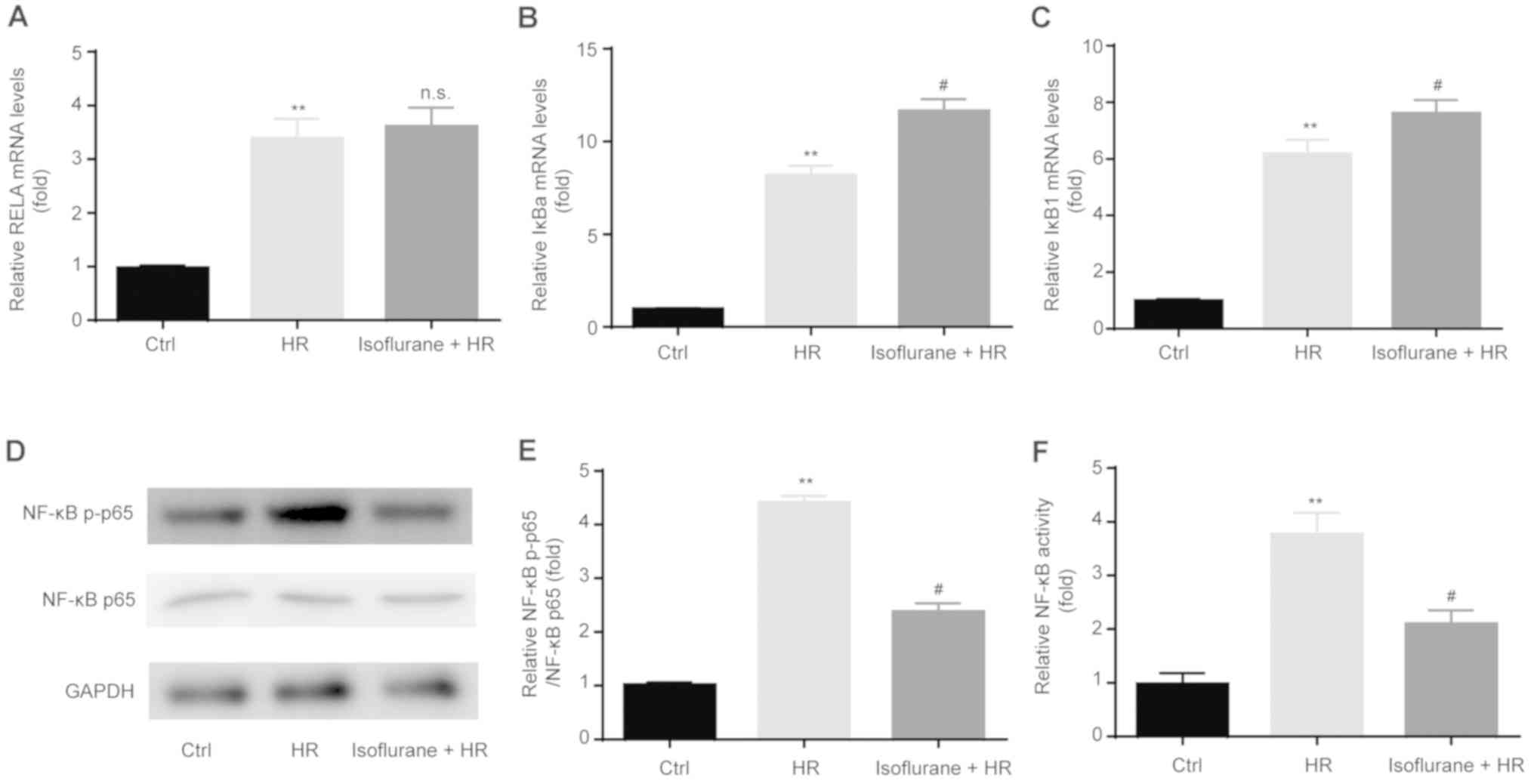Isoflurane suppresses lung ischemia‑reperfusion injury by inactivating NF‑κB and inhibiting cell apoptosis
- Authors:
- Published online on: September 10, 2020 https://doi.org/10.3892/etm.2020.9202
- Article Number: 74
-
Copyright: © Lv et al. This is an open access article distributed under the terms of Creative Commons Attribution License.
Abstract
Introduction
Lung ischemia-reperfusion injury (LIRI) is an intricate pathological process that occurs during numerous clinical conditions, including lung transplantation, pulmonary embolism, resuscitation for circulatory arrest and cardiopulmonary bypass cardiac surgery (1,2). Lung transplantation, which induces the most severe form of LIRI, causes primary graft failure, leading to short- and long-term morbidity and mortality (3); therefore, novel therapeutic strategies are required to improve the clinical outcomes of patients with LIRI.
Ischemia-reperfusion (IR) induces inflammation and injury by rapidly activating the innate immune system (4). The mechanisms underlying LIRI involve the release of inflammatory cytokines and an increase in their expression levels, which results in cell damage, necrosis and apoptosis in the lungs (5,6).
In 1988, Warltier et al (7) reported that pretreatment of cells with isoflurane improved left ventricular systolic function following occlusion of the left anterior descending coronary artery for 15 min. To date, the protective functions of isoflurane against IR injury (IRI) have been confirmed by numerous studies. For example, Kehl et al (8) reported that low concentration isoflurane was sufficient to precondition myocardial tissue against infarction. In addition, Lv et al (9) indicated that pretreatment of rats with isoflurane ameliorated IR combined with lipopolysaccharide (LPS)-induced liver injury. Liang et al (10) reported that isoflurane pretreatment of rats also attenuated renal IRI by reducing inflammation and apoptosis. Furthermore, it has been reported that emulsified isoflurane pretreatment of rats ameliorated hepatic IR-induced lung injury (11). However, whether isoflurane attenuates LIRI via an anti-inflammatory mechanism and the inhibition of apoptosis is not completely understood; therefore, the present study aimed to investigate the mechanisms underlying the effects of isoflurane during LIRI.
Materials and methods
Cell culture and hypoxia-reoxygenation (HR) model
A549 cells are derived from a human alveolar cell carcinoma and are the most widely used in vitro model of type 2 pulmonary alveolar epithelial cells, possessing multiple properties of these cells (12). A549 cells (American Type Culture Collection) were cultured in DMEM (Gibco; Thermo Fisher Scientific, Inc.) supplemented with 4.5 g/l glucose (Gibco; Thermo Fisher Scientific, Inc.), 10% fetal bovine serum (Gibco; Thermo Fisher Scientific, Inc.) and 1% penicillin/streptomycin (Gibco; Thermo Fisher Scientific, Inc.) in a humidified incubator with 5% CO2 at 37˚C.
A549 cells were pretreated with isoflurane (1.4% v/v) prior to HR induction according to a previously method (13). Briefly, cells were placed in a sealed acrylic chamber with a circular opening in which a rubber cannula was inserted and a mixture of 95% air and 5% CO2 was delivered. Subsequently, isoflurane was delivered into the chamber using a vaporizer for 60 min. Untreated cells served as a control group. Capnography was conducted using the Networked Multiparameter Veterinary Monitor LifeWindow 6000V (Digicare Animal Health).
An in vitro model of LIRI was established by HR induction. A549 cells were placed in a hypoxic chamber (0% O2) and incubated with 95% N2 and 5% CO2 for 25 min at room temperature. Subsequently, cells in the hypoxic chamber (95% N2 and 5% CO2) were incubated in a 37˚C incubator for 3 h to establish hypoxia. A549 cells were transferred to a normoxic incubator with 5% CO2 at 37˚C for 1 h to induce reoxygenation. Following incubation under hypoxic conditions for 3 h, the partial percentage of O2 in the culture media was 5% compared with 21% in the normoxic culture media.
Cell proliferation assay
Cells (3x104 cells/well) were seeded into 96-well plates and cultured at 37˚C with 5% CO2. Cell proliferation was determined using the Cell Counting Kit-8 (CCK-8; Dojindo Molecular Technologies, Inc.) assay. CCK-8 solution (10 µl) was added to each well and incubated at 37˚C for 3 h. The absorbance of each well was measured at a wavelength of 450 nm using a spectrophotometer.
Cell apoptosis assay
Cells (1x106 cells/well) were seeded into 6-well plates and cultured at 37˚C with 5% CO2. Cells were stained at room temperature for 10 min in the dark using the Annexin V-FITC/PI Apoptosis Detection kit (Sigma-Aldrich; Merck KGaA) according to the manufacturer's protocol. Early and late apoptotic cells were analyzed using a BD FACSCalibur flow cytometer (BD Biosciences) and CellQuest software (version 3.3; BD Biosciences).
Detection of interleukin (IL)-8, IL-6, superoxide dismutase (SOD) and malondialdehyde (MDA) content
IL-8 (cat. no. S8000C) and IL-6 (cat. no. S6050) ELISA kits (R&D Systems, Inc.) were used to measure IL-8 and IL-6 protein concentrations, according to the manufacturer's protocols. The induction of oxidative stress was evaluated using SOD (cat. no. A001-3) and MDA (cat. no. A003-1) assay kits (Nanjing Jiancheng Bioengineering Institute) according to the manufacturer's protocol.
Detection of NF-κB activity
A549 cells (1x105) were seeded into 24-well plates and transfected with the pBIIx-luc NF-κB-dependent luciferase reporter construct (0.4 mg; GenScript Biotech Corporation) and the Renilla luciferase vector (Promega Corporation) using Lipofectamine® 3000 reagent (Invitrogen; Thermo Fisher Scientific, Inc.). Following incubation for 24 h at 37˚C, cells were pretreated with isoflurane and HR was induced according to the aforementioned protocol. Subsequently, luciferase activities were detected using a Dual-Luciferase Reporter assay system (Promega Corporation) according to the manufacturer's protocol. Firefly luciferase activity was normalized to Renilla luciferase activity.
Western blotting
Western blotting was performed to measure the protein expression levels of NF-κB phosphorylated (p)-p65, NF-κB p65, Bax, Bcl-2 and proliferating cell nuclear antigen (PCNA). Total protein was extracted from A549 cells using cold RIPA buffer (Roche Diagnostics) and total protein was quantified using the Bicinchoninic Acid Protein Assay kit (Applygen Technologies, Inc.). Proteins (15 µg/lane) were separated via SDS-PAGE on 10% gels and transferred onto nitrocellulose membranes. The membranes were incubated overnight at 4˚C with primary antibodies which were all purchased from Cell Signaling Technology, Inc. targeted against: Bax (cat. no. 2772; 1:1,000) and Bcl-2 (cat. no. 3498; 1:1,000), PCNA (cat. no. 13110; 1:1,000), NF-κB p-p65 (cat. no. 3033; 1:1,000), NF-κB p65 (cat. no. 8242; 1:1,000) and GAPDH (cat. no. 5174; 1:1,000). Following primary antibody incubation, the membranes were blocked in 5% non-fat milk at room temperature for 1 h and incubated with anti-rabbit IgG secondary antibody (cat. no. 7074, 1:10,000; Cell Signaling Technology, Inc.) at room temperature for 2 h. Protein bands were visualized by enhanced chemiluminescence (Thermo Fisher Scientific, Inc.) using the Odyssey Infrared Imaging system (LI-COR Biosciences). Densitometry was quantified by ImageJ software (version. 1.8.0; National institutes of Health). GAPDH was used as the loading control.
Reverse transcription-quantitative PCR (RT-qPCR)
Total RNA was extracted from A549 cells using the Easystep Universal RNA Extraction kit (Promega Corporation) and RNA concentration was quantified using a NanoDrop spectrophotometer (NanoDrop; Thermo Fisher Scientific, Inc.). Total RNA was reverse transcribed into cDNA at 37˚C for 10 min followed by incubation at 85˚C for 5 sec using the M-MLV reverse transcriptase [50 mM Tris-HCl (pH 8.3), 40 mM KCl, 6 mM MgCl2, 1 mM DTT, 0.5 mM [3H]dTTP, 0.1 mM poly(A), 0.1 mM oligo(dT)12-18, 0.1 mg/ml BSA and reverse transcriptase, Thermo Fisher Scientific, Inc.]. Subsequently, qPCR was performed using SYBRGreen Master Mix (Promega Corporation) and the Real-Time PCR system (Bio-Rad Laboratories, Inc.). The primer sequences were as listed: PCNA forward, 5'-GCGTGAACCTCACCAGTATGT-3' and reverse, 5'-TCTTCGGCCCTTAGTGTAATGAT-3'; BAX forward, 5'-CACCAGCTCTGAACAGATCATGA-3' and reverse, 5'-TCAGCCCATCTTCTTCCAGATGT-3'; Bcl-2 forward, 5'-CACCCCTGGCATCTTCTCCTT-3' and reverse, 5'-AGCGTCTTCAGAGACAGCCAG-3'; IL-6 forward, 5'-AGCCACTCACCTCTTCAGAACGAA-3' and reverse, 5'-TACTCATCTGCACAGCTCTGGCTT-3'; IL-8 forward, 5'-ATGACTTCCAAGCTGGCCGTGGCT-3' and reverse, 5'-TCTCAGCCCTCTTCAAAAACTTCT-3'; RELA forward, 5'-CCCACGAGCTTGTAGGAAAGG-3' and reverse, 5'-GGATTCCCAGGTTCTGGAAAC-3'; IκBa forward, 5'-ACCTGGTGTCACTCCTGTTGA-3' and reverse, 5'-CTGCTGCTGTATCCGGGTG-3'; IκB1, forward, 5'-GATATCGCCCTGATCTTGCT-3' and reverse, 5'-AGGTTGGCTCCTGACATCAC-5'; and GAPDH forward, 5'-TTGGTATCGTGGAAGGAC-3' and reverse, 5'-TGTCATCATATTTGGCAGGTT-3'. The thermocycling conditions were as listed: 94˚C for 30 sec; followed by 40 cycles of 94˚C for 5 sec, 60˚C for 15 sec and 72˚C for 10 sec). mRNA expression levels were quantified using the 2-ΔΔCq method (14) and normalized to the internal reference gene GAPDH.
Statistical analysis
Data are presented as the mean ± standard deviation. Statistical analyses were performed using SPSS software (version 14.0; SPSS, Inc.). Comparisons among groups were analyzed by one-way ANOVA followed by Tukey's post hoc test. P<0.05 was considered to indicate a statistically significant difference.
Results
Isoflurane pretreatment reverses HR-induced reductions in cell proliferation
The effects of isoflurane on cell proliferation were assessed. Cell proliferation in the HR group was significantly decreased compared with the control group, whereas pretreatment with isoflurane reversed the effects of HR on cell proliferation (Fig. 1A).
In addition, the expression levels of the cell proliferation-associated molecule, PCNA, were assessed in the different groups by RT-qPCR and western blotting. The mRNA expression levels of PCNA were significantly decreased in the HR group compared with the control group (Fig. 1B). Conversely, pretreatment with isoflurane increased PCNA mRNA expression in the HR group (Fig. 1B). PCNA protein levels displayed a similar pattern to PCNA mRNA levels (Fig. 1C and D).
Isoflurane pretreatment inhibits HR-induced cell apoptosis
Subsequently, the effects of isoflurane on cell apoptosis were investigated. The rate of apoptosis was significantly increased in the HR group compared with the control group, and pretreatment with isoflurane significantly reversed HR-induced cell apoptosis (Fig. 2).
Isoflurane pretreatment reverses HR-induced increases in the Bax/Bcl-2 ratio
Furthermore, the expression levels of apoptosis-related proteins Bax and Bcl-2 were examined in the different groups by RT-qPCR and western blotting. The mRNA expression levels of Bax were significantly higher in the HR group compared with the control group, whereas the opposite effect was observed for Bcl-2. Pretreatment with isoflurane significantly reversed the HR-induced effects on apoptosis-related genes (Fig. 3A and B). The western blotting results indicated that the protein expression levels of Bax and Bcl-2 displayed a similar trend to the mRNA expression levels (Fig. 3C and D).
Isoflurane pretreatment reverses HR-induced increases in MDA concentration and decreases in SOD activity
Subsequently, the effects of isoflurane on reactive oxygen species (ROS)-associated markers, including SOD activity and MDA levels, were investigated. Significantly higher MDA concentrations and lower SOD activity levels were observed in the HR group compared with the control group; however, pretreatment with isoflurane significantly reversed these effects (Fig. 4A and B).
Isoflurane pretreatment reduces HR-induced inflammatory cytokine release
The effect of isoflurane on the production and release of inflammatory cytokines, including IL-8 and IL-6, was examined in A549 cells and the cell culture medium, respectively. The mRNA expression levels and protein concentrations of IL-8 and IL-6 in the HR group were significantly increased compared with the control group; however, pretreatment with isoflurane significantly reduced the expression and production of IL-8 and IL-6 compared with the HR group (Fig. 5).
Isoflurane pretreatment suppresses HR-induced NF-κB activation
To investigate the effect of isoflurane on the expression of NF-κB-associated genes, RT-qPCR was performed. Increased levels of NF-κB inhibitor α (IκBα) and IκB1 were observed in the HR group compared with the control group. Pretreatment with isoflurane upregulated the mRNA expression levels of IκBa and IκB1, whereas these effects were not observed for RELA proto-oncogene, NF-κB subunit (RELA; Fig. 6A-C).
NF-κB activity was determined following HR and isoflurane pretreatment by western blotting and the dual-luciferase reporter assay. The HR group displayed significantly increased p-p65 expression levels compared with the control group, which were significantly decreased by isoflurane pretreatment (Fig. 6D and E). Furthermore, pretreatment with isoflurane significantly suppressed the enhanced NF-κB activation in the HR group (Fig. 6F).
Discussion
LIRI is the second most common cause of respiratory insufficiency (15,16). Although the current treatment strategies used for lung protection are effective, they may not be sufficient to prevent LIRI (17); therefore, identifying a novel strategy to protect against LIRI is required.
Apoptosis is the process of programmed cell death and is associated with the pathogenesis of LIRI. It has been reported that the inhibition of apoptosis may ameliorate LIRI (18). The present study suggested that LIRI induced an increased rate of apoptosis compared with the control group, which was significantly reversed by pretreatment with isoflurane. Furthermore, the expression levels of apoptosis-related markers, including Bcl-2 and Bax, were investigated. The Bcl-2 family can be divided into three subgroups that modulate cell apoptosis: Anti-apoptotic Bcl-2, proapoptotic Bax and the BH3-only subfamily (19,20). The results indicated that LIRI induced significantly higher Bax expression and reduced Bcl-2 expression compared with the control group, and pretreatment with isoflurane significantly reversed LIRI-induced effects.
In a previous study, isoflurane pretreatment reduced injury to normal lung cells in Sprague-Dawley rats by regulating tumor necrosis factor-α, intercellular adhesion molecular-1 and NF-κB (11). In the present study, isoflurane pretreatment reversed LIRI-induced reductions in cell proliferation. In addition, the expression of PCNA, a cell proliferation-associated marker (21), was significantly reduced in the LIRI group compared with the control group, which was reversed by isoflurane pretreatment.
During LIRI, the imbalance between the demand and supply of pulmonary oxygen leads to oxidative stress (2), which leads to an excessive accumulation of ROS (16,22). MDA is the final product of peroxidation, and SOD is an antioxidant enzyme that protects the epithelium/endothelium in the lung from oxidant injury and inflammation (23,24). The results of the present study demonstrated that LIRI increased MDA levels and decreased SOD activity, and that these effects were reversed by isoflurane pretreatment.
Moreover, the infiltrating ability of inflammatory cells in the lungs during LIRI is considered a crucial source of ROS production (16,25). LIRI is associated with the expression of IL-6 and IL-8 in small airway epithelial cells (26). Isoflurane decreased LPS-induced production of proinflammatory cytokines in rats, including IL-6(27). A similar protective role was identified in a rat model of renal IRI (28). The present study indicated that the expression levels of IL-8 and IL-6 in the LIRI group were significantly higher compared with the control group, which was reversed by isoflurane pretreatment.
NF-κB is an important transcription factor that is involved in inflammation and LIRI; when activated, NF-κB promotes the expression of various inflammatory molecules, including cytokines, chemokines and adhesion molecules (29,30), contributing to lung injury. Sevoflurane pretreatment of the heart tissue decreased NF-κB activation and IR-induced production of inflammatory mediators, thus attenuating myocardial IRI (31). Emulsified isoflurane pretreatment of A549 cells displayed a similar effect on NF-κB activation. In the present study, higher mRNA expression levels of IκBa, IκB1 and RELA (an NF-κB subunit) were observed in the LIRI group compared with the control group. Isoflurane pretreatment significantly increased the expression levels of IκBa and IκB1, whereas this effect was not observed for RELA expression. In addition, significantly increased levels of p-p65 NF-κB were observed in the LIRI group compared with the control group; however, isoflurane pretreatment decreased LIRI-induced effects on p-p65. Furthermore, the dual-luciferase reporter assay suggested that isoflurane pretreatment inactivated NF-κB hyperactivation in the LIRI group.
Collectively, the results indicated that isoflurane suppressed LIRI by inhibiting the activation of NF-κB and the induction of cell apoptosis, suggesting that isoflurane may serve as a therapeutic agent for LIRI.
Acknowledgements
Not applicable.
Funding
Not applicable.
Availability of data and materials
The datasets used and/or analyzed during the current study are available from the corresponding author on reasonable request.
Authors' contributions
NL and XL carried out the experiments and analyzed the data. NL prepared the manuscript. All authors read and approved the final manuscript for publication.
Ethics approval and consent to participate
Not applicable.
Patient consent for publication
Not applicable.
Competing interests
The authors declare that they have no competing interests.
References
|
Ovechkin AV, Lominadze D, Sedoris KC, Robinson TW, Tyagi SC and Roberts AM: Lung ischemia-reperfusion injury: Implications of oxidative stress and platelet-arteriolar wall interactions. Arch Physiol Biochem. 113:1–12. 2007.PubMed/NCBI View Article : Google Scholar | |
|
Den Hengst WA, Gielis JF, Lin JY, Van Schil PE, De Windt LJ and Moens AL: Lung ischemia-reperfusion injury: A molecular and clinical view on a complex pathophysiological process. Am J Physiol Heart Circ Physiol. 299:H1283–H1299. 2010.PubMed/NCBI View Article : Google Scholar | |
|
Porteous MK, Diamond JM and Christie JD: Primary graft dysfunction: Lessons learned about the first 72 h after lung transplantation. Curr Opin Organ Transplant. 20:506–514. 2015.PubMed/NCBI View Article : Google Scholar | |
|
Kreisel D and Goldstein DR: Innate immunity and organ transplantation: Focus on lung transplantation. Transpl Int. 26:2–10. 2013.PubMed/NCBI View Article : Google Scholar | |
|
Ng CS, Wan S, Arifi AA and Yim AP: Inflammatory response to pulmonary ischemia-reperfusion injury. Surg Today. 36:205–214. 2006.PubMed/NCBI View Article : Google Scholar | |
|
Welborn MB III, Douglas WG, Abouhamze Z, Auffenburg T, Abouhamze AS, Baumhofer J, Seeger JM, Pruitt JH, Edwards PD, Chizzonite R, et al: Visceral ischemia-reperfusion injury promotes tumor necrosis factor (TNF) and interleukin-1 (IL-1) dependent organ injury in the mouse. Shock. 6:171–176. 1996.PubMed/NCBI | |
|
Warltier DC, Al Wathiqui MH, Kampine JP and Schmeling WT: Recovery of contractile function of stunned myocardium in chronically instrumented dogs is enhanced by halothane or isoflurane. Anesthesiology. 69:552–565. 1988.PubMed/NCBI View Article : Google Scholar | |
|
Kehl F, Krolikowski JG, Mraovic B, Pagel PS, Warltier DC and Kersten JR: Is isoflurane-induced preconditioning dose related? Anesthesiology. 96:675–680. 2002.PubMed/NCBI View Article : Google Scholar | |
|
Lv X, Li Q, Huang SD, Wu FX, Yang LQ and Yu WF: Isoflurane pretreatment reduced liver injury induced by ischemia/reperfusion combined with lipopolysaccharide in rats. Zhongguo Wei Zhong Bing Ji Jiu Yi Xue (Chinese). 20:271–274. 2008.PubMed/NCBI | |
|
Liang Y, Li Z, Mo N, Li M, Zhuang Z, Wang J, Wang Y and Guo X: Isoflurane preconditioning ameliorates renal ischemia-reperfusion injury through antiinflammatory and antiapoptotic actions in rats. Biol Pharm Bull. 37:1599–1605. 2014.PubMed/NCBI View Article : Google Scholar | |
|
Lv X, Wang ZM, Huang SD, Song SH, Wu FX and Yu WF: Emulsified isoflurane preconditioning reduces lung injury induced by hepatic ischemia/reperfusion in rats. Int J Med Sci. 8:353–361. 2011.PubMed/NCBI View Article : Google Scholar | |
|
Lieber M, Smith B, Szakal A, Nelson-Rees W and Todaro G: A continuous tumor-cell line from a human lung carcinoma with properties of type II alveolar epithelial cells. Int J Cancer. 17:62–70. 1976.PubMed/NCBI View Article : Google Scholar | |
|
Yue T, Roth Z'graggen B, Blumenthal S, Neff SB, Reyes L, Booy C, Steurer M, Spahn DR, Neff TA, Schmid ER and Beck-Schimmer B: Postconditioning with a volatile anaesthetic in alveolar epithelial cells in vitro. Eur Respir J. 31:118–125. 2008.PubMed/NCBI View Article : Google Scholar | |
|
Livak KJ and Schmittgen TD: Analysis of relative gene expression data using real-time quantitative PCR and the 2(-Delta Delta C (T)) method. Methods. 25:402–408. 2001.PubMed/NCBI View Article : Google Scholar | |
|
Apostolakis E, Filos KS, Koletsis E and Dougenis D: Lung dysfunction following cardiopulmonary bypass. J Card Surg. 25:47–55. 2010.PubMed/NCBI View Article : Google Scholar | |
|
Weyker PD, Webb CA, Kiamanesh D and Flynn BC: Lung ischemia reperfusion injury: A bench-to-beside review. Semin Cardiothorac Vasc Anesth. 17:28–43. 2013.PubMed/NCBI View Article : Google Scholar | |
|
Apostolakis EE, Koletsis EN, Baikoussis NG, Siminelakis SN and Papadopoulos GS: Strategies to prevent intraoperative lung injury during cardiopulmonary bypass. J Cardiothorac Surg. 5(1)2010.PubMed/NCBI View Article : Google Scholar | |
|
Tang PS, Mura M, Seth R and Liu M: Acute lung injury and cell death: How many ways can cells die? Am J Physiol Lung Cell Mol Physiol. 294:L632–L641. 2008.PubMed/NCBI View Article : Google Scholar | |
|
Lindsten T, Ross AJ, King A, Zong WX, Rathmell JC, Shiels HA, Ulrich E, Waymire KG, Mahar P, Frauwirth K, et al: The combined functions of proapoptotic Bcl-2 family members bak and bax are essential for normal development of multiple tissues. Mol Cell. 6:1389–1399. 2000.PubMed/NCBI View Article : Google Scholar | |
|
Oda E, Ohki R, Murasawa H, Nemoto J, Shibue T, Yamashita T, Tokino T, Taniguchi T and Tanaka N: Noxa, a BH3-only member of the Bcl-2 family and candidate mediator of p53-induced apoptosis. Science. 288:1053–1058. 2000.PubMed/NCBI View Article : Google Scholar | |
|
Goodlad RA: Quantification of epithelial cell proliferation, cell dynamics, and cell kinetics in vivo. Wiley Interdiscip Rev Dev Biol 6: 2017. | |
|
De Perrot M, Liu M, Wadderll TK and Kashavjee S: Ischemia reperfusion induced lung injury. Am J Respir Crit Care Med. 167:490–511. 2003.PubMed/NCBI View Article : Google Scholar | |
|
Till GO, Hatherill JR, Tourtellotte WW, Lutz MJ and Ward PA: Lipid peroxidation and acute lung injury after thermal trauma to skin. Evidence of a role for hydroxyl radical. Am J Pathol. 119:376–384. 1985.PubMed/NCBI | |
|
Baradaran Rahimi V, Rakhshandeh H, Raucci F, Buono B, Shirazinia R, Samzadeh Kermani A, Maione F, Mascolo N and Askari VR: Anti-inflammatory and anti-oxidant activity of portulaca oleracea extract on lps-induced rat lung injury. Molecules. 4: pii(E139)2019.PubMed/NCBI View Article : Google Scholar | |
|
Forman HJ and Thomas MJ: Oxidant production and bactericidal activity of phagocytes. Annu Rev Physiol. 48:669–680. 1986.PubMed/NCBI View Article : Google Scholar | |
|
Watanabe K, Iwahara C, Nakayama H, Iwabuchi K, Matsukawa T, Yokoyama K, Yamaguchi K, Kamiyama Y and Inada E: Sevoflurane suppresses tumour necrosis factor-a-induced inflammatory responses in small airway epithelial cells after anoxia/reoxygenation. Br J Anaesth. 110:637–645. 2013.PubMed/NCBI View Article : Google Scholar | |
|
Li QF, Zhu YS, Jiang H, Xu H and Sun Y: Isoflurane preconditioning ame-liorates endotoxin-induced acute lung injury and mortality in rats. Anesth Analg. 109:1591–1597. 2009.PubMed/NCBI View Article : Google Scholar | |
|
Hashiguchi H, Morooka H, Miyoshi H, Matsumoto M, Koji T and Sumikaw K: Isoflurane protects renal function against ischemia and reperfusion through inhibition of protein kinases, JNK and ERK. Anesth Analg. 101:1584–1589. 2005.PubMed/NCBI View Article : Google Scholar | |
|
Yoshidome H, Kato A, Edwards MJ and Lentsch AB: Interleukin-10 inhibits pulmonary NF-kappaB activation and lung injury induced by hepatic ischemia-reperfusion. Am J Physiol. 277:919–923. 1999.PubMed/NCBI View Article : Google Scholar | |
|
Colletti LM, Cortis A, Lukacs N, Kunkel SL, Green M and Strieter RM: Tumor necrosis factor up-regulates intercellular adhesion molecule 1, which is important in the neutrophil-dependent lung and liver injury associated with hepatic ischemia and reperfusion in the rat. Shock. 10:182–191. 1998.PubMed/NCBI View Article : Google Scholar | |
|
Zhong C, Zhou Y and Liu H: Nuclear factor kappaB and anesthetic preconditioning during myocardial ischemia-reperfusion. Anesthesiology. 100:540–545. 2004.PubMed/NCBI View Article : Google Scholar |



